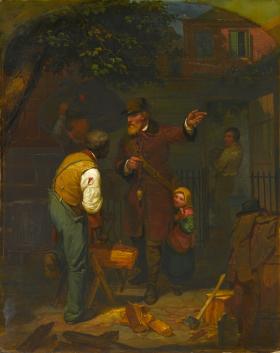1. Assign students to read a textbook description of the immigrant experience in the United States from 1850 to 1880.
2. Hold a brief class discussion analyzing and evaluating the immigrant experience from 1850 to 1880 based on the following questions:
- Why did immigrants choose to leave their homelands and come to the United States in the second half of the 19th century?
- Why were Americans upset with the pattern of immigration during this time?
- How did these immigrants fare in their new homeland?
- How did the second and third generations of these immigrants fare? What factors might account for any of the differences in experience?
3. Students will use the Image Analysis Chart to analyze and examine A German Immigrant Inquiring His Way.
4. Students will use the Image Analysis Chart to analyze and examine Thomas Nast's political cartoon Throwing Down the Ladder by Which They Rose (1870) from the Harper's Weekly Web site.
5. Hold a brief class discussion focused on the following questions:
- Which immigrant group(s) is the focus of these pictures?
- What does the artist/cartoonist suggest about how these immigrants are viewed by Americans?
- What does the image reveal about American attitudes and policies toward immigrants in the year in which it was created?
6. Divide the class into groups of four students for a short debate on the following resolution: It is necessary for the United States to restrict certain groups of immigrants from coming to the United States during certain times. Pairs of students in each group should prepare to argue the affirmative or negative side of the resolution, using knowledge and research about the Timeline of U.S. Immigration Policy.
• The teacher will use class discussion and debate to evaluate the students' analysis of how the images of immigrants reflected political and social attitudes toward them in the United States.
• The Image Analysis Chart, class discussion, and debate may be used to assess the students' interpretation of visual images in the context of historical and political developments.
context
debate
immigrant
immigration
Dijkstra, Bram. American Expressionism: Art and Social Change 1920–1950. New York: Harry N. Abrams, 2003.
Konzett, Delia Caparoso. Ethnic Modernisms: Anzi Yezierska, Zora Neale Hurston, Jean Rhys, and the Aesthetics of Dislocation. New York: Palgrave-Macmillan, 2002.
Pozzetta, George E. Nativism, Discrimination, and Images of Immigrants. New York: Taylor and Francis, 1991.
Beginning in the 1840s, the rising tide of immigrants, especially people from non-English speaking Europe, alarmed many native-born Americans. During the 1850s, the short-lived American Party (popularly known as the Know-Nothing Party) gained national prominence by its virulent opposition to foreign immigration. This is the unsettling context for an otherwise amusing encounter between the Old World and the New. The father of an immigrant family, presumably just off the boat, stops to ask directions of an elderly black woodchopper. At the time this picture was painted, many people would have viewed both the German and the African-American as unwanted aliens and a threat to the nation's social and political stability.


